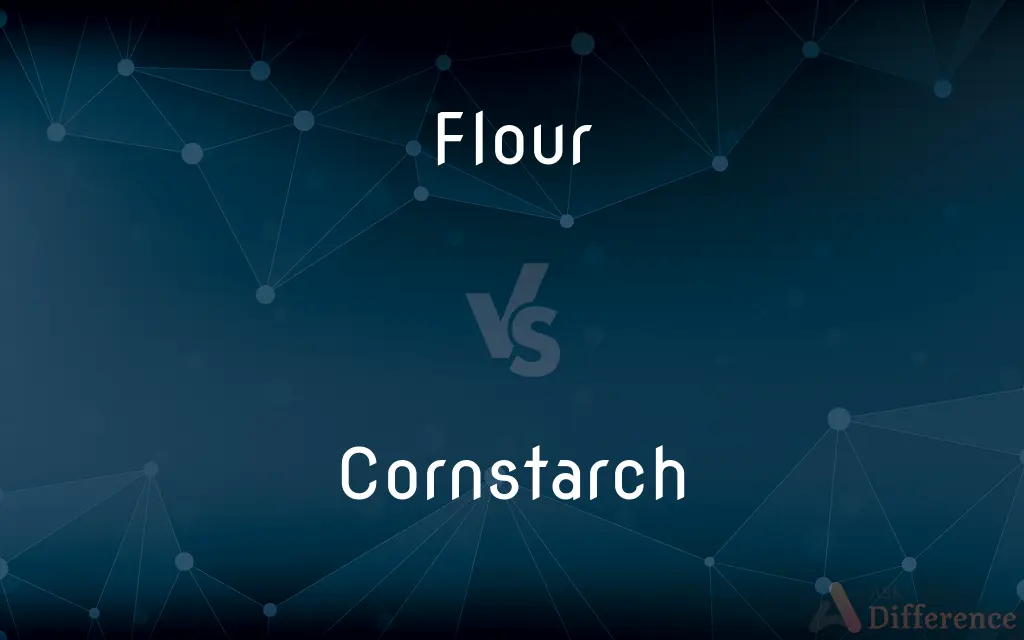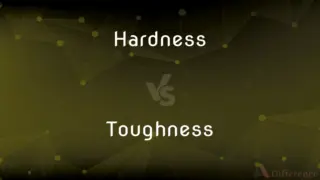Flour vs. Cornstarch — What's the Difference?
By Tayyaba Rehman & Fiza Rafique — Updated on April 18, 2024
Flour, made from ground wheat, is versatile in baking and cooking, thickening sauces slowly; cornstarch, derived from corn, thickens quickly but requires careful handling to avoid clumping.

Difference Between Flour and Cornstarch
Table of Contents
ADVERTISEMENT
Key Differences
Flour is primarily used in baking as it provides structure to bread, cakes, and pastries due to its gluten content, whereas cornstarch is typically used as a thickening agent in sauces, gravies, and soups because it is gluten-free and has a higher thickening power.
Flour can be used to make a roux for thickening sauces, providing a subtle flavor and requiring longer cooking to eliminate a raw taste, while cornstarch gives a glossy finish and thickens quickly, but it can become spongy if overcooked.
In terms of nutritional content, flour contains a higher amount of protein and fiber, beneficial for dietary health, whereas cornstarch is almost pure starch and higher in carbohydrates, making it less ideal for regular consumption in a balanced diet.
Flour is versatile enough to be used in both savory and sweet dishes, offering a mild, slightly nutty flavor that complements various ingredients. On the other hand, cornstarch is flavorless, making it a good choice for dishes where a neutral thickener is desired.
When mixed with cold liquids, flour needs to be whisked thoroughly to prevent lumps, whereas cornstarch can mix more easily with cold liquids, but both require heating to activate their thickening properties.
ADVERTISEMENT
Comparison Chart
Base Ingredient
Ground wheat
Corn
Uses
Baking, thickening, coating
Thickening, coating
Thickening Quality
Thickens gradually, requires cooking
Thickens rapidly, effective at lower temperatures
Flavor Contribution
Mild, slightly nutty
Neutral, does not alter flavor profiles
Nutritional Content
Higher in protein and fiber
Higher in carbohydrates, lower in protein
Compare with Definitions
Flour
Ground meal from grains or nuts.
She used rice flour for her gluten-free cookies.
Cornstarch
Fine, white powder from corn used as a thickener.
Cornstarch was added to thicken the pie filling.
Flour
Thickening agent in sauces.
He whisked some flour into the broth to thicken it.
Cornstarch
Gluten-free alternative to flour.
Cornstarch is often used in gluten-free recipes.
Flour
Base ingredient in baking.
Flour is essential for making bread rise.
Cornstarch
Quick thickening agent.
She used cornstarch to quickly thicken the gravy.
Flour
Coating for frying.
The chicken was dredged in flour before frying.
Cornstarch
Anti-caking agent.
Cornstarch is used to prevent sugar from clumping.
Flour
Binding agent in recipes.
Flour helps bind the ingredients in meatballs.
Cornstarch
Coating for crispy frying.
The shrimp were coated in cornstarch before deep frying.
Flour
Flour is a powder made by grinding raw grains, roots, beans, nuts, or seeds. Flours are used to make many different foods.
Cornstarch
Finely ground maize flour, used as a thickener in cooking; cornflour.
Flour
A powder obtained by grinding grain, typically wheat, and used to make bread, cakes, and pastry.
Cornstarch
Starch prepared from corn grains, used industrially and as a thickener in cooking.
Flour
Sprinkle (something, especially a work surface or cooking utensil) with a thin layer of flour.
Cornstarch
A very fine starch powder derived from corn (maize) used in cooking as a thickener, to keep things from sticking, or as an anti-caking agent.
Flour
Grind (grain) into flour.
Cornstarch
Starch made from Indian corn, esp. a fine white flour used for puddings, etc.
Flour
A fine, powdery foodstuff obtained by grinding and sifting the meal of a grain, especially wheat, used chiefly in baking.
Cornstarch
Starch prepared from the grains of corn; used in cooking as a thickener
Flour
Any of various similar finely ground or powdered foodstuffs, as of cassava, chickpeas, or bananas.
Flour
A soft, fine powder.
Flour
To cover or coat with flour.
Flour
To make into flour.
Flour
Powder obtained by grinding or milling cereal grains, especially wheat, or other foodstuffs such as soybeans and potatoes, and used to bake bread, cakes, and pastry.
Flour
The food made by grinding and bolting cleaned wheat (not durum or red durum) until it meets specified levels of fineness, dryness, and freedom from bran and germ, also containing any of certain enzymes, ascorbic acid, and certain bleaching agents.
Flour
Powder of other material.
Wood flour, produced by sanding wood
Mustard flour
Flour
Obsolete form of flower
Flour
(transitive) To apply flour to something; to cover with flour.
Flour
(transitive) To reduce to flour.
Flour
(intransitive) To break up into fine globules of mercury in the amalgamation process.
Flour
The finely ground meal of wheat, or of any other grain; especially, the finer part of meal separated by bolting; hence, the fine and soft powder of any substance; as, flour of emery; flour of mustard.
Flour
To grind and bolt; to convert into flour; as, to flour wheat.
Flour
To sprinkle with flour.
Flour
Fine powdery foodstuff obtained by grinding and sifting the meal of a cereal grain
Flour
Cover with flour;
Flour fish or meat before frying it
Flour
Convert grain into flour
Common Curiosities
Can flour and cornstarch be used interchangeably?
They are not directly interchangeable due to different thickening properties and nutritional contents.
Why is flour used in baking?
Flour provides structure and texture to baked goods, thanks to its gluten content.
Is flour healthier than cornstarch?
Flour generally contains more nutrients like fiber and protein compared to cornstarch, which is mostly carbohydrate.
How does flour affect the flavor of a dish?
Flour can add a slightly nutty flavor to dishes, depending on the type used.
What is flour?
Flour is a powder made by grinding raw grains, roots, beans, nuts, or seeds.
Why is cornstarch preferred for thickening sauces?
Cornstarch has a neutral flavor and high thickening power, making it ideal for sauces and gravies.
What is cornstarch?
Cornstarch is a starch powder derived from corn used primarily for cooking and baking.
What happens if you cook cornstarch too long?
Overcooking cornstarch can break down its thickening properties, resulting in a thinner texture.
Is cornstarch gluten-free?
Yes, cornstarch is naturally gluten-free, making it suitable for those avoiding gluten.
Can cornstarch be used in baking?
Cornstarch is sometimes used in baking, typically combined with other flours to soften the texture of the baked goods.
Share Your Discovery

Previous Comparison
Hardness vs. Toughness
Next Comparison
Jargon vs. SlangAuthor Spotlight
Written by
Tayyaba RehmanTayyaba Rehman is a distinguished writer, currently serving as a primary contributor to askdifference.com. As a researcher in semantics and etymology, Tayyaba's passion for the complexity of languages and their distinctions has found a perfect home on the platform. Tayyaba delves into the intricacies of language, distinguishing between commonly confused words and phrases, thereby providing clarity for readers worldwide.
Co-written by
Fiza RafiqueFiza Rafique is a skilled content writer at AskDifference.com, where she meticulously refines and enhances written pieces. Drawing from her vast editorial expertise, Fiza ensures clarity, accuracy, and precision in every article. Passionate about language, she continually seeks to elevate the quality of content for readers worldwide.















































